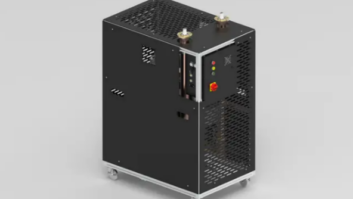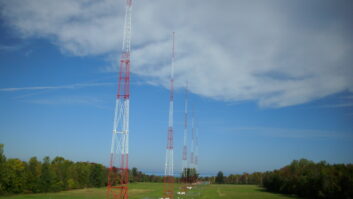
The Empire State Building is in a competition for broadcast transmission tenants. One engineer says rivalry between rooftop platforms is good for New York broadcasters.
Photo courtesy Empire State Realty Trust NEW YORK — Radio and TV broadcasters here are being presented with two high-rise transmission options that eventually could alter the rooftop antenna skyline in the country’s largest media market.
As we have reported, Durst Organization is hoping to establish an RF transmission platform atop the new One World Trade Center downtown, and is seeking broadcaster commitments. Now the owners of the Empire State Building have shared with Radio World some details of a tower reconfiguration project, pending approval of its TV and radio broadcast tenants.
Radio groups appear to be moving forward cautiously, according to market observers, with their decision either to stay put at Empire or to be lured to the rooftop system proposed at 1 WTC.
Durst, a real estate development firm, controls 1 WTC in a partnership with The Port Authority of New York and New Jersey. Company officials said the building has space for every station in the market to install transmitters and sufficient mast capacity for all to participate in a hypothetical master antenna on the 408-foot spire. The rooftop has been leased to Durst Broadcasting LLC, the entity that will run the proposed broadcast facility, and is viewed by developers as a successor to the broadcast facilities lost in the collapse of the twin towers in the 9/11 terrorist attacks.

The One World Trade Center The skyscraper, which stretches to 1,776 feet, now is expected to open in November when its first tenants take occupancy, according to John Lyons, vice president and director of broadcast communications for Durst.
Multimedia publisher Condé Nast is expected to occupy some 1.2 million square feet on floors 20 through 44 at 1 WTC, according to various published reports.
“We are still talking to broadcasters” about the proposed FM antenna, Lyons said.
ESB
Currently, most of the market’s major radio and TV broadcasters operate transmission facilities at the Empire State Building. Empire, which stands 1,254 feet tall plus a 200-foot steel broadcast tower.

Shane O’Donoghue is director of broadcasting for the Empire State Building.
Photo by Peggy Miles The building is owned by Empire State Realty Trust, a publicly traded company. In the year ending Dec. 31, 2013, the trust derived approximately $20 million of revenue from Empire’s broadcasting licenses and related leased space for radio, television and data communications services, according to its annual report.
Empire is in mid-town Manhattan. Nineteen FM radio stations call it home to their primary signals; 16 of those are on a three-bay, four-sided radio master antenna built by Electronics Research Inc. and installed in 1994. Three FMs are on a second smaller master antenna, often referred to as Empire’s “mini-master.” The master FM combiner is on the 85th floor; the mini-master FM combiner is on the 87th.
Fifteen TV stations also operate from the building — 11 full-power and four LPTV stations — with a combiner on the 85th floor.
Pending broadcaster commitments, officials at Empire have proposed building a 19-station master FM combiner and antenna, said Shane O’Donoghue, director of broadcasting for Empire State Realty Trust.
The timing of the Empire tower reconfiguration project depends in part on the FCC’s repurposing of the 600 MHz spectrum, expected in 2015; this may result in some TV broadcasters choosing to move frequency, O’Donoghue said. “The TV repack is going to force us to reconfigure TV facilities and antennas, but it also is presenting [Empire] an opportunity to offer radio broadcasters the chance for a new radio transmission antenna infrastructure,” he said.
Lyons at 1 WTC told Radio World previously that the TV frequency repurposing is creating uncertainty and making radio and TV broadcasters reluctant to commit to the new RF structure there.
MASTER FM
The Master FM Antenna Group at Empire is a consortium of broadcasters that owns the FM combiner (also built by ERI in 1994). The group includes iHeartMedia, CBS Radio, New York Public Radio, Emmis Communications and several other broadcast groups. Empire owns the master FM antenna and leases space to broadcasters.

Rob Bertrand, market chief engineer for CBS Radio New York, at the transmission facility for FM stations WCBS, WFAN and WBMP at Empire. He’s also a member of the executive committee for the Master FM Antenna Group at Empire.
Photo by Peggy Miles Rob Bertrand, chief engineer for CBS Radio in New York and member of the executive committee for the Master FM Antenna Group, said Empire is still working through significant logistics to develop a plan and present it to the broadcasters. “We have seen a number of potential designs for both the antenna and combiner systems. We have yet to see the terms associated with those plans.”
But the consortium, which exists to maintain the facilities at Empire, is not actually in a position to greenlight the proposed antenna reconfiguration project, he said. “The consortium does not act unilaterally; so each broadcaster will be making decisions independently in terms of what to support at the Empire State Building or whether to consider moving to One World Trade Center,” Bertrand said.
A challenge at Empire will be managing the sequence of events if not all broadcasters elect to remain at Empire.
“One of the big questions we have is what happens if not everyone buys into what will be proposed at Empire. How do you migrate broadcasters if not everyone is on board?” Bertrand said.
But Bertrand believes competition between two or more rooftop platforms in New York City is good for broadcasters. “I think it helps drive innovation and drives the market in terms of lease structures and that sort of thing.”
Bertrand said the master FM system at Empire “is 20 years old, so it’s time to look at the facilities and come up with a new long-term plan.”
O’Donoghue of Empire said he has “complete design plans and specifications” for its tower reconfiguration. He said construction documents have been bid and leveled with pricing for all options, which have been presented to broadcast tenants.
“There are still many unknowns with the FCC TV spectrum auction. There are many variables still in play there. We want as much data as possible from the FCC before we finalize terms of our project,” O’Donoghue said.
Investment bank Greenhill & Co. in October released a study in conjunction with the commission that estimated the value of the TV spectrum to give broadcasters some guidance, O’Donoghue said. “We are in close contact with the FCC. I expect we will have a much clearer picture at some point in 2015,” he said.
Once broadcasters are ready to proceed, “we stand ready to execute” the design and construction plans, O’Donoghue said. He declined to say what level of commitment from tenants would be needed before ESB would proceed.
Despite Empire’s push for a new master FM antenna, O’Donoghue said the current antenna and combiner system is in good shape and has been well maintained. “There is no immediate need for radio broadcasters to make upgrades. This is just an opportunity to take advantage of the timing of the TV spectrum repack.”
O’Donoghue said the final decision about when to proceed with the tower reconfiguration project will be Empire’s. He described the working relationship between Empire and the Master FM Antenna Group as a partnership that manages the FM combiner, transmitter rooms and the rest of the antenna infrastructure.
“I’m sure [broadcasters] will have their preferences. We are acting more as facilitators and project managers.”
BIDDING PROCESS
Empire, whose radio broadcast antenna history dates to 1930, has worked with several consultants and antenna manufacturers capable of building a master radio antenna system within the timeframe of the FCC requirements for the DTV buildout, O’Donoghue said. ERI, Dielectric, Jampro and others have participated in the FM master antenna bidding process, he said.
The reconfiguration project would include replacing Empire’s older Alford combiner and antenna, in place since 1965 and currently used as a backup, he said. The Alford was the first master FM combiner system anywhere that was designed to allow individual FM stations to broadcast simultaneously from one source.
O’Donoghue said a planned new RF shield will isolate the main antenna from the auxiliary antenna. In addition, the building has already installed RF monitoring systems above and beyond FCC regulatory requirements, he said.
Radio stations would continue to broadcast from Empire during construction. “Building a new aux antenna would be the first part of the project. That would be completed in one summer construction season,” according to O’Donoghue. “Then all 19 of the FMs would be placed on the new auxiliary antenna during construction of the new master FM antenna.”
As for the competitive situation, O’Donoghue, who has led Empire’s broadcasting facilities since 2008, said he welcomes the new rooftop competition from 1 WTC.
“We think it strengthens the broadcasters’ understanding that they are going to get the best by staying at Empire. Not only do we have the internal capability with our engineering expertise but also with the construction management team in place here,” he said.
He emphasized that the Empire State Building, in addition to the broadcast antenna tower, has significant antenna aperture space on all sides of the building from the 90th to 102nd floors, known as the Mooring Mast, according to O’Donoghue. “We call the unique top of the building the Mooring Mast since it was conceptually designed to moor dirigibles, which was a new way to travel in the early 1930s.” No aircraft ever did moor there.
The unique aperture space and lower setbacks on floors 81, 85, 87, 88, 89 and 90accommodate auxiliary antennas and communications antennas for STL, electronic news gathering and point-to-point microwave, O’Donoghue added.
Also offering broadcast infrastructure in the city is the Condé Nast Building at 4 Times Square in midtown Manhattan. That building, owned and managed by Durst, has 14 FM transmitters and a Shively master FM antenna installed in 2004. The site is used primarily as an auxiliary platform for radio broadcasters and some television, according to Durst officials.












